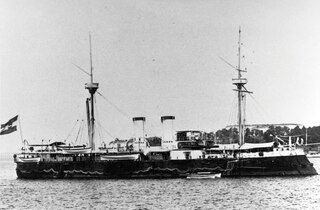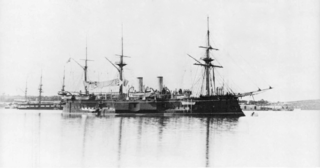 W
WA naval arms race between the Austrian Empire and Italy began in the 1860s when both ordered a series of ironclad warships, steam-propelled vessels protected by iron or steel armor plates and far more powerful than all-wood ships of the line. These ships were constructed to establish control over the Adriatic Sea in the event of a conflict between the two countries.
 W
WSMS Custoza was an ironclad warship built for the Austro-Hungarian Navy in the 1870s, the only member of her class. She was the first Austro-Hungarian ironclad to be built after the navy studied the results of the Battle of Lissa of 1866; she was also the first iron-hulled capital ship to be built for the Austro-Hungarian Navy. She was laid down in November 1869, launched in August 1872, and completed in February 1875. Her career was fairly limited, in part due to reduced naval budgets in the 1870s that also delayed her completion. Custoza was somewhat more active in the 1880s, taking part in an international naval demonstration against the Ottoman Empire in 1880, being modernized in 1882, and a trip to Spain for the Barcelona Universal Exposition in 1888. The ship became a training ship in 1902, was converted into a barracks ship in 1914, and after World War I, was awarded as a war prize to Italy. Custoza was immediately broken up.
 W
WSMS Erzherzog Albrecht was an ironclad warship built for the Austro-Hungarian Navy in the 1870s, the only member of her class. Her design was similar to the ironclad Custoza, but Erzherzog Albrecht was built to a smaller size; like Custoza, she was an iron-hulled casemate ship armed with a battery of eight heavy guns. The ship was laid down in June 1870, was launched in April 1872, and was commissioned in June 1874. The ship's service career was limited; tight naval budgets precluded an active fleet policy in the 1870s, which did not markedly improve in the 1880s. Her first period of active service came in 1881 and 1882, when she helped suppress a revolt in Cattaro Bay. In 1908, she was converted into a tender for the gunnery training school, having been renamed Feuerspeier. In 1915, she became a barracks ship, and after World War I ended in 1918, was ceded to Italy as a war prize. She was renamed Buttafuoco, served in the Italian Navy as a hulk through World War II before being scrapped in 1950.
 W
WSMS Kaiser was a 92-gun wooden ship of the line of the Austrian Navy, the last vessel of the type, and the only screw-driven example, to be built by the Austrians. She was built by the naval shipyard in Pola; she was laid down in March 1855, was launched in October 1858, and was completed the following year. The ship took part in the Second Schleswig War of 1864, but saw no action during her deployment to the North Sea. Kaiser did see action during the Seven Weeks' War two years later, during which she took part in the Battle of Lissa as the flagship of Anton von Petz, commander of the Austrian 2nd Division. Kaiser engaged several Italian ironclads simultaneously, rammed one—Re di Portogallo—and damaged another—Affondatore—with gunfire. In doing so, she became the only wooden ship of the line to engage an ironclad warship in battle.
 W
WSMS Kronprinz Erzherzog Rudolf was a unique ironclad warship built for the Austro-Hungarian Navy in the 1880s. The last ironclad completed for the Austro-Hungarian Navy, Kronprinz Erzherzog Rudolf was laid down in January 1884, launched in July 1887, and completed in September 1889. She was armed with a main battery of three 30.5-centimeter (12 in) guns and had compound steel plating of the same thickness on her armored belt. The ship had an uneventful career, in large part due to her rapid obsolescence. She made trips to foreign countries to represent Austria-Hungary, but was reduced to a coastal defense ship by 1906. She continued in this role through World War I, based at Cattaro Bay, where her crew took part in the Cattaro Mutiny in early 1918. After the war, Kronprinz Erzherzog Rudolf was transferred to the Navy of the Kingdom of Serbs, Croats and Slovenes and renamed Kumbor, but she remained in their inventory for only a year, being sold for scrap in 1922.
 W
WSMS Kronprinzessin Erzherzogin Stephanie was an ironclad warship built for the Austro-Hungarian Navy in the 1880s, the last vessel of that type to be built for Austria-Hungary. The ship, named for Archduchess Stephanie, Crown Princess of Austria, was laid down in November 1884, was launched in April 1887 and completed in July 1889. She was armed with a pair of 30.5-centimeter (12 in) guns in open barbettes and had a top speed of 17 knots. Her service was limited, in large part due to the rapid pace of naval development in the 1890s, which quickly rendered her obsolescent. As a result, her career was generally limited to routine training and the occasional visit to foreign countries. In 1897, she took part in an international naval demonstration to force a compromise over Greek and Ottoman claims to the island of Crete. Kronprinzessin Erzherzogin Stephanie was decommissioned in 1905, hulked in 1910, and converted into a barracks ship in 1914. After Austria-Hungary's defeat in World War I, the ship was transferred to Italy as a war prize and was eventually broken up for scrap in 1926.
 W
WSMS Lissa, named for the Battle of Lissa, was a unique ironclad warship built for the Austro-Hungarian Navy in the 1860s and 1870s, the only member of her class. She was the first casemate ship built for Austria-Hungary, she was armed with a main battery of twelve 9-inch (229 mm) guns in a central armored casemate, unlike the earlier broadside ironclads. Construction of the ship lasted from June 1867 to May 1871, and was delayed by budgetary shortfalls; the lack of funding also plagued the ship during her career, preventing her from taking an active role in the fleet. She spent the majority of her time in service laid up in Pola, apart from a lengthy reconstruction in 1880–1881. Lissa was ultimately stricken from the fleet in 1892 and broken up for scrap starting the following year.
 W
WSMS Tegetthoff was an ironclad warship of the Austro-Hungarian Navy. She was built by the Stabilimento Tecnico Triestino shipyard in Trieste, between April 1876 and October 1881. She was armed with a main battery of six 28 cm (11 in) guns mounted in a central-battery. The ship had a limited career, and did not see action. In 1897, she was reduced to a guard ship in Pola, and in 1912 she was renamed Mars. She served as a training ship after 1917, and after the end of World War I, she was surrendered as a war prize to Italy, which sold her for scrapping in 1920.